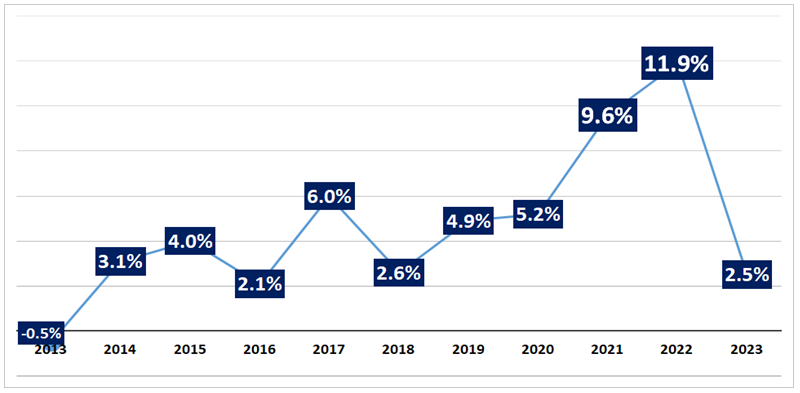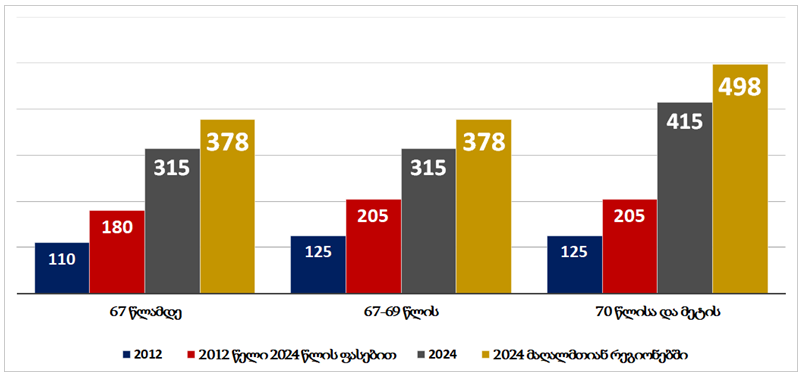Giorgi Vashadze: “The real purchasing power of pensions has decreased over the past 12 years.”
Verdict: FactCheck concludes that Giorgi Vashadze’s statement is Lie.
The old age pension constituted GEL 110-125 in 2012 and GEL 315-415 in 2024 whilst mountainous region residents receive GEL 378-498. Although a 64% increase in consumer prices from 2013 to 2023 resulted in a substantial decrease in the real growth rate as compared to the nominal growth rate of pensions, the aforementioned has not turned negative.
Pensions grew by 54%-143%, taking inflation into account, varying across age groups and geographic locations, with most cases experiencing a growth rate of 74%-102%. Average annual inflation in real terms was 4.6% rather than 10%-11% in the years spanning 2013-2023.
The real growth rate of pensions outpaced that of the real economy during the governance of the Georgian Dream political party. When considering 2024 projections (a 5.2% growth), the real economy from 2013-2024 achieved a total growth of 79% whilst pension funds grew by 110%. Moreover, the relative share of pension funds to the GDP increased from 3.8% to 4.6%, further driven by an increasing number of pensioners.
Real pensions have increased, ranging from at least 54% to 74%-102%, and even higher for the population aged over 70 years and those living in mountainous regions. Giorgi Vashadze’s claim regarding the decreased real purchasing power of pensions is not accurate. Therefore, FactCheck concludes that Giorgi Vashadze’s statement is LIE.
Analysis
The leader of the Strategy Aghmashenebeli political party, Giorgi Vashadze, during his appearance on the TV Pirveli show Dghis Ambebi (Stories of the Day) on 1 March stated (from 5:12): “Looking at the real figures, pensions decreased rather than increased over the past 12 years; I mean in terms of purchasing power. The purchasing power of pensions has decreased.”
Traditionally, Giorgi Vashadze focused on the government change in 2012 when comparing pensions. The old age pension was GEL 67 for individuals under 67 years of age and GEL 125 for those aged above 67 as of October 2012. Similarly, pensions vary across age groups in 2024 with pensioners under the age of 70 years receiving GEL 315 and those above 70 receiving GEL 415. Furthermore, pensioners residing in mountainous regions receive an additional 20% on top of the aforementioned age group pensions.
Nominal pensions have increased 2.9-fold and 3.3-fold since 2012 and almost four-fold for mountainous village residents. Whilst inflation has dampened real growth, it has not led to negative growth.
Georgia witnessed notably high inflation rates of 9.6% and 11.9% in 2021 and 2022, respectively. Inflation exceeded the National Bank’s target rate of 3% in 2017, 2019 and 2020 as well. However, deflation was observed in 2013 and consumer prices only increased by 2.5% in 2023.
Graph 1: Consumer Price Index Dynamics (Inflation)

Source: National Statistics Office of Georgia
Consumer prices have increased by 64% in total from 2013 to 2023. In terms of purchasing power, the pension of GEL 110 in 2012 is equivalent to GEL 180 today and the pension of GEL 125 from the initial period is now comparable to GEL 205 today. Adjusting for previous prices, today’s GEL 315 can purchase the same number of goods and services as GEL 192 from 2012 whilst GEL 415 today equals GEL 252 from 12 years ago.
The real pension for the population aged 60-67 has increased by 74%, for the population aged 67-69[1] by 54% and for the population aged above 70 years by 102%. The real growth was 110%, 84% and 143% for each age group, respectively, in mountainous regions.
An additional sum has been provided to the residents of mountainous regions since September 2016. A total of 82,000 people were receiving this additional amount, constituting 9.8% of pensioners as of December 2023.
Graph 2: Nominal and Real Pensions

Source: Social Service Agency and National Statistics Office of Georgia
The average annual inflation rate amounted to 4.6% from 2013 to 2023. Consumer prices had to increase by 10%-11% at the minimum for them to have surpassed the nominal growth of pensions which was only observed in 2021 and 2022.
Furthermore, the funds allocated for pensions relative to the GDP have increased. Up to GEL 1.1 billion (GEL 1.068 billion) was spent on pension provision, constituting 3.83% of the GDP in 2012. Whereas the allocated budget for pensions exceeds GEL 3.9 billion (GEL 3.930 billion), amounting to 4.57% of the projected GDP in 2024.
The real economy of Georgia grew by 70% from 2013 to 2023 and it is projected to reach 79% in 2024 if the projected growth rate realises at 5.2%. Moreover, the sum allocated for pension provision would increase by 110% in real terms during this period. In addition to the fact that the growth rate of pensions has surpassed the growth rate of the economy, except for the 67-69 age group, the number of pensioners has increased by 23%, reaching 838,000 in December 2023 from 682,000 in October 2012.
Despite the overall inflation rate of 64% from 2013 to 2023, real pensions have expanded by 54%-143% across various age groups. Furthermore, the real growth rate of pensions has exceeded the real growth rate of the economy in most cases and the funds allocated for pensions relative to the GDP have increased as well. Giorgi Vashadze’s claim regarding the decreased real purchasing power of pensions is not accurate. Therefore, FactCheck concludes that Giorgi Vashadze’s statement is Lie.
[1] This age group (67-69 years) was separated out as the age differentiation threshold was 67 in 2012, changing to 70 starting from 2024. A total of 118,000 people, constituting 14% of the entire pensioner population, were within this age group as of 2023, according to GeoStat.








